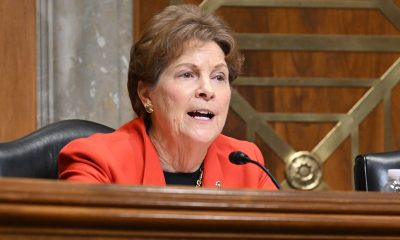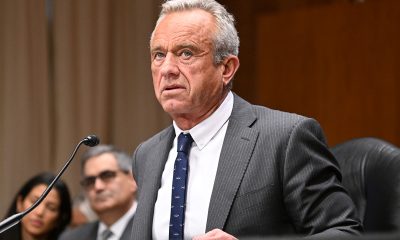Health
Cornell University study on impact of discrimination on LGBTQ of color
Around 25% of LGBTQ youth have attempted suicide, but the rates are starkly higher for LGBTQ youth of color than their white counterparts
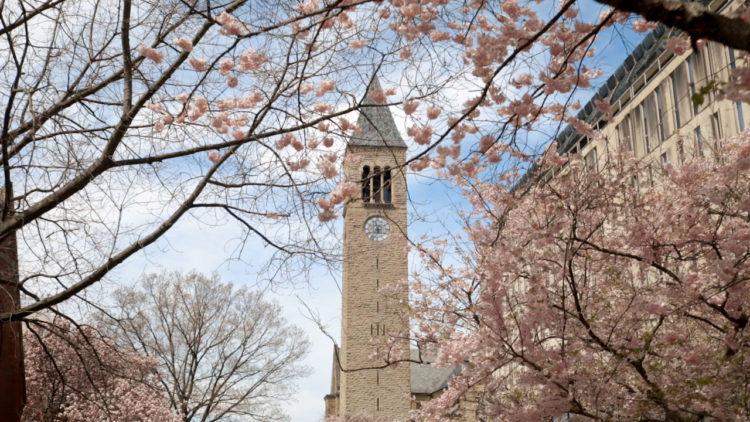
ITHACA, NY. – Cornell University’s What We Know Project in conjunction with a coalition of leading LGBTQ rights groups last month published a comprehensive curation of data on studies that chart the intersection of anti-LGBTQ and racial discrimination.
The findings found that discrimination inflicts profoundly greater harm on LGBTQ people of color in a wide range of areas, including grossly disproportionate rates of: experiencing discrimination over the past year, poorer mental and physical health, greater economic insecurity, and attempts to die by suicide.
In addition, LGBTQ people of color are more likely than white LGBTQ people to live in states without protections against discrimination and that state anti-LGBTQ laws harm LGBTQ people.
“This research brief makes clear the tangible harms that discrimination inflicts on LGBTQ people of color, and the urgent need for public policy that reflects what the research tells us about how we can reduce those harms,” said Dr. Nathaniel Frank, the study’s author.
Highlights of the research brief’s findings include:
LGBTQ people are more likely than non-LGBTQ people to be people of color, and Black LGBTQ Americans are disproportionately likely to live in states without protections against discrimination. For example, 42% of LGBT people are people of color compared to 32% of non-LGBT people and the majority of Black LGBT Americans live in the South (51.4%, more than twice the share of any other region), where most states lack anti-discrimination protections.
LGBTQ people of color face higher odds of discrimination than both non-LGBTQ individuals and LGBTQ white people. For example, LGBTQ people of color are more than twice as likely to experience anti-LGBTQ discrimination (slurs or other verbal abuse) when applying for jobs than white LGBTQ individuals (32% vs. 13%). LGBTQ people of color are more than twice as likely as white LGBTQ people to experience anti-LGBTQ discrimination when interacting with the police (24% vs. 11%).
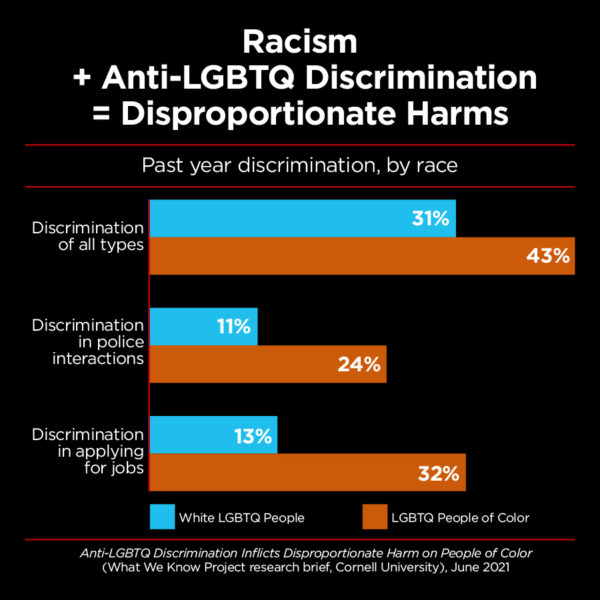
Black LGBT Americans are more likely to experience economic insecurity than Black non-LGBT Americans. For example, the majority of Black LGBT people (56%) live in low-income households (below 200% of the federal poverty level) compared to 49% of Black non-LGBT Americans, and Black LGBT adults are also more likely to experience food insecurity than Black non-LGBT adults (37% compared to 27%).
Hundreds of studies conclude that experiencing anti-LGBTQ discrimination increases the risks of poor mental and physical health, including depression, anxiety, suicidality, PTSD, substance use, and psychological distress.
LGBTQ people of color face disproportionate odds of suicidality, which is linked to discrimination. For example, while 12% of white LGBTQ youth attempted suicide, the rate is 31% for LGBTQ Native/Indigenous youth, 21% for LGBTQ Black youth, and 18% of LGBTQ Latinx youth.
While supportive laws, family, and peers lower the risk of poor health outcomes for LGBTQ people of color, anti-LGBTQ state laws inflict tangible harm on sexual minority populations. For example, states with “denial of service” laws that give license to discriminate against LGBT residents between 2014 and 2016 were linked with a 46% increase in LGBT mental distress. Black LGBTQ youth who reported high levels of support from at least one person, or who had access to an LGBTQ-affirming space, reported attempting suicide at lower rates than those who lacked such support (16% vs. 24%).

Supportive laws, family, and peers lower the risk of poor health outcomes for LGBTQ people of color.
• Suicide attempts by LGBT youth dropped by 7 percent in states that legalized same-sex marriage.22
• The corollary is that anti-LGBTQ state laws inflict tangible harm on sexual minority populations. States with “denial of service” laws that give license to discriminate against LGBT residents were linked with a 46% increase in LGBT mental distress.23
• Black LGBTQ youth who reported high levels of support from at least one person, or who had access to an LGBTQ-affirming space, reported attempting suicide at lower rates than those who lacked such support (16% vs. 24%). Those with high levels of family support had rates of past-year attempted suicide nearly one third as high as those who lacked such support (22% vs. 8%).24
• Protective measures that have been found to help reduce anxiety, depression, and suicidality among LGBTQ youth include: Establishing inclusive practices and anti-discrimination policies; peer, community, and family support, including dedicated school groups; access to affirmative mental health and social services; societal confrontation of attitudes and norms that exacerbate minority stress; and practitioner training and interventions designed to disrupt negative coping responses and build resilience.
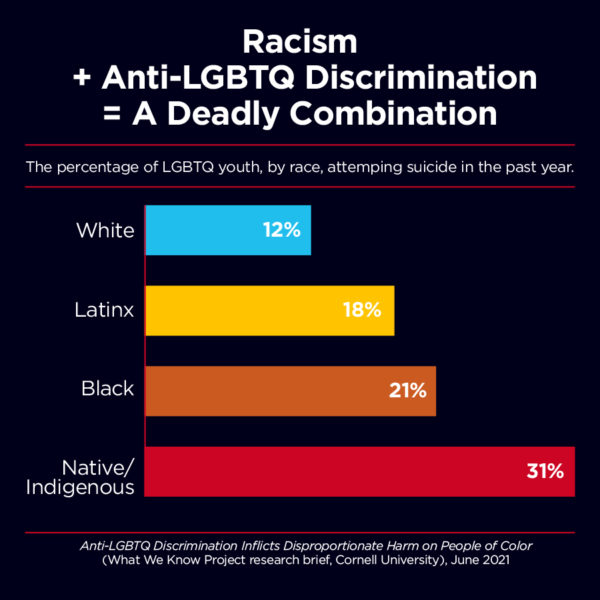
Experiencing discrimination is associated with greater odds of harm to psychological and economic well-being, which is reflected in data on disparities for LGBTQ people of color.
• Hundreds of studies conclude that experiencing anti-LGBTQ discrimination increases the risks of poor mental and physical health, including depression, anxiety, suicidality, PTSD, substance use, and psychological distress.
• LGBT people of color have work-place experiences that are more negative than those of white LGBT employees, reporting that their success and work-life balance are fostered less extensively, they have less transparent evaluations, and they are respected less by supervisors.
• Among LGBTQ people surveyed, 51% of Black respondents say discrimination harms their ability to be hired, compared with 33% of white respondents; 41% say it has an impact on their ability to retain employment, compared with 31% of white respondents; 77% of Black respondents report that discrimination impacts their psychological well-being, a rate nearly 50% higher than the total LGBTQ survey population.
• While racial discrimination on its own is not associated with mental health disorders, the combination of racial discrimination with gender and/or sexual orientation discrimination is significantly associated with increased odds of a past-year mental health disorder.
LGBTQ people of color face disproportionate odds of suicidality, which is linked to discrimination.
• Around 25% of LGBTQ youth of all races have attempted suicide, but the rates are starkly higher for LGBTQ youth of color than their white counterparts: While 12% of white LGBTQ youth have attempted suicide, the rate is 31% for LGBTQ Native/Indigenous youth, 21% for LGBTQ Black youth, and 18% for LGBTQ Latinx youth.
• In a 95%-non-white LGBT sample, those who report experiencing anti-LGBT victimization (such as bullying and harassment) are 2.5 times more likely to report a past-year suicide attempt compared to those who do not report victimization.
• Black LGBTQ youth who experience anti-LGBTQ discrimination face twice the rate of past year suicide attempts compared to youth who do not (27% vs. 12%). Black LGBTQ youth who experience race-based discrimination also face higher odds of attempting suicide than those who do not (20% vs. 14%).
• Black LGB adults are over 40% more likely to have made a serious suicide attempt in their lifetime than white LGB adults.
• Latinx and Native American/Pacific Islander LGBT youth are 50% more likely to attempt suicide than white LGBT youth. Latinx LGBT girls are nearly twice as likely to attempt suicide than white LGBT youth.
• LGBTQ students who experience discrimination “based on multiple social identities” report more use of deliberate self-harm compared to LGBTQ students who experience racial discrimination alone or who do not experience significant discrimination of any kind.
Reflecting on the study’s findings, key executives from participating LGBTQ Advocacy groups weighed in:
“These painful figures highlight an indisputable link between discrimination, economic security, mental and physical health. People with multiple stigmatized, marginalized social and political identities, particularly Black LGBTQ+/Same Gender Loving people, bear a disproportionate amount of the weight illustrated by the data in this study. Statutory equality for LGBTQ+ people nationwide is a necessary foundation to remove the gaps in existing civil rights laws if we are to ever live up to our country’s founding promises of life, liberty, and the pursuit of happiness for all,” said David Johns, Executive Director, National Black Justice Coalition.
The majority of Black LGBTQ people live in the South, with nearly half (44%) of all Black women couples raising children. Even today, most of these states still do not protect LGBTQ people from discrimination and have overtly discriminatory laws on their books. It is no wonder the disparities are so profound and it is a testament to the strength and resilience of our people that they are doing as well as they are. For our community and for our children it’s time for federal action!” said Kierra Johnson, Executive Director, National LGBTQ Task Force.
“This important brief only further solidifies what we have known for a very long time—the combination of racism and anti-LGBTQ discrimination has serious and long-lasting effects for the health and well-being of LGBTQ people of color. This research highlights why federal non-discrimination protections are overdue and vital to protecting the most some of the most underrepresented and vulnerable members of our community. Federal anti-discrimination protections are absolutely necessary in protecting and supporting all LGBTQ people, and this is especially true for LGBTQ people of color,” said Imani Rupert-Gordon, Executive Director, National Center for Lesbian Rights.
“Study after study shows that nondiscrimination protections improve economic opportunities, public safety, and physical and mental well-being of LGBTQ people. It is well past time for the essential protections available only in some of our states and cities to be extended to all LGBTQ Americans, especially LGBTQ people of color, who are disproportionately burdened by the lack of protections, ” said Kasey Suffredini, CEO and National Campaign Director, Freedom for All Americans.
Monkeypox
US contributes more than $90 million to fight mpox outbreak in Africa
WHO and Africa CDC has declared a public health emergency
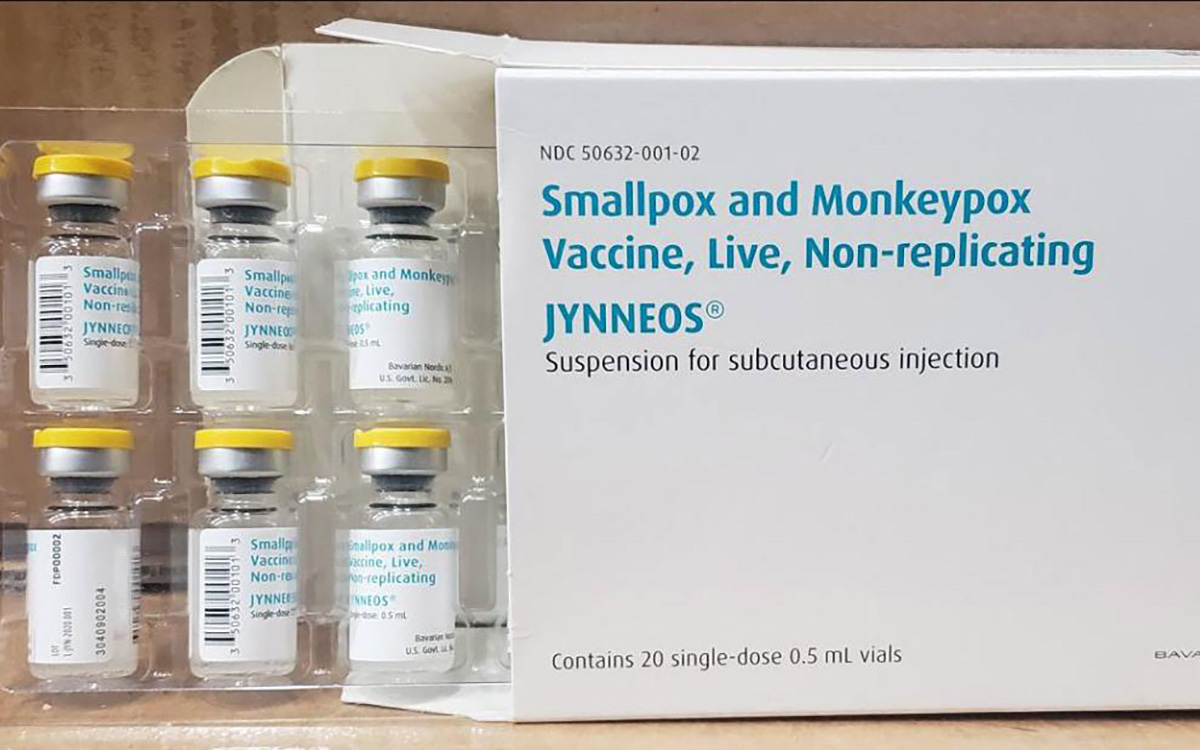
The U.S. has contributed more than $90 million to the fight against the mpox outbreak in Africa.
The U.S. Agency for International Development on Tuesday in a press release announced “up to an additional” $35 million “in emergency health assistance to bolster response efforts for the clade I mpox outbreak in Central and Eastern Africa, pending congressional notification.” The press release notes the Biden-Harris administration previously pledged more than $55 million to fight the outbreak in Congo and other African countries.
“The additional assistance announced today will enable USAID to continue working closely with affected countries, as well as regional and global health partners, to expand support and reduce the impact of this outbreak as it continues to evolve,” it reads. “USAID support includes assistance with surveillance, diagnostics, risk communication and community engagement, infection prevention and control, case management, and vaccination planning and coordination.”
The World Health Organization and the Africa Centers for Disease Control and Prevention last week declared the outbreak a public health emergency.
The Washington Blade last week reported there are more than 17,000 suspected mpox cases across in Congo, Uganda, Kenya, Rwanda, and other African countries. The outbreak has claimed more than 500 lives, mostly in Congo.
Health
Mpox outbreak in Africa declared global health emergency
ONE: 10 million vaccine doses needed on the continent

Medical facilities that provide treatment to gay and bisexual men in some East African countries are already collaborating with them to prevent the spread of a new wave of mpox cases after the World Health Organization on Wednesday declared a global health emergency.
The collaboration, both in Uganda and Kenya, comes amid WHO’s latest report released on Aug. 12, which reveals that nine out of every 10 reported mpox cases are men with sex as the most common cause of infection.
The global mpox outbreak report — based on data that national authorities collected between January 2022 and June of this year — notes 87,189 of the 90,410 reported cases were men. Ninety-six percent of whom were infected through sex.
Sexual contact as the leading mode of transmission accounted for 19,102 of 22,802 cases, followed by non-sexual person-to-person contact. Genital rash was the most common symptom, followed by fever and systemic rash.
The WHO report states the pattern of mpox virus transmission has persisted over the last six months, with 97 percent of new cases reporting sexual contact through oral, vaginal, or anal sex with infected people.
“Sexual transmission has been recorded in the Democratic Republic of Congo among sex workers and men who have sex with men,” the report reads. “Among cases exposed through sexual contact in the Democratic Republic of the Congo, some individuals present only with genital lesions, rather than the more typical extensive rash associated with the virus.”
The growing mpox cases, which are now more than 2,800 reported cases in at least 13 African countries that include Kenya, Uganda, Rwanda, and prompted the Africa Centers for Disease Control and Prevention this week to declare the disease a public health emergency for resource mobilization on the continent to tackle it.
“Africa has long been on the frontlines in the fight against infectious diseases, often with limited resources,” said Africa CDC Director General Jean Kaseya. “The battle against Mpox demands a global response. We need your support, expertise, and solidarity. The world cannot afford to turn a blind eye to this crisis.”
The disease has so far claimed more than 500 lives, mostly in Congo, even as the Africa CDC notes suspected mpox cases across the continent have surged past 17,000, compared to 7,146 cases in 2022 and 14,957 cases last year.
“This is just the tip of the iceberg when we consider the many weaknesses in surveillance, laboratory testing, and contact tracing,” Kaseya said.
WHO, led by Director General Tedros Adhanom Ghebreyesus, also followed the Africa CDC’s move by declaring the mpox outbreak a public health emergency of international concern.
The latest WHO report reveals that men, including those who identify as gay and bisexual, constitute most mpox cases in Kenya and Uganda. The two countries have recorded their first cases, and has put queer rights organizations and health care centers that treat the LGBTQ community on high alert.
The Uganda Minority Shelters Consortium, for example, confirmed to the Washington Blade that the collaboration with health service providers to prevent the spread of mpox among gay and bisexual men is “nascent and uneven.”
“While some community-led health service providers such as Ark Wellness Clinic, Children of the Sun Clinic, Ice Breakers Uganda Clinic, and Happy Family Youth Clinic, have demonstrated commendable efforts, widespread collaboration on mpox prevention remains a significant gap,” UMSC Coordinator John Grace stated. “This is particularly evident when compared to the response to the previous Red Eyes outbreak within the LGBT community.”
Grace noted that as of Wednesday, there were no known queer-friendly health service providers to offer mpox vaccinations to men who have sex with men. He called for health care centers to provide inclusive services and a more coordinated approach.
Although Grace pointed out the fear of discrimination — and particularly Uganda’s Anti-Homosexuality Act — remains a big barrier to mpox prevention through testing, vaccination, and treatment among queer people, he confirmed no mpox cases have been reported among the LGBTQ community.
Uganda so far has reported two mpox cases — refugees who had travelled from Congo.
“We are for the most part encouraging safer sex practices even after potential future vaccinations are conducted as it can also be spread through bodily fluids like saliva and sweat,” Grace said.
Grace also noted that raising awareness about mpox among the queer community and seeking treatment when infected remains a challenge due to the historical and ongoing homophobic stigma and that more comprehensive and reliable advocacy is needed. He said Grindr and other digital platforms have been crucial in raising awareness.
The declarations of mpox as a global health emergency have already attracted demand for global leaders to support African countries to swiftly obtain the necessary vaccines and diagnostics.
“History shows we must act quickly and decisively when a public health emergency strikes. The current Mpox outbreak in Africa is one such emergency,” said ONE Global Health Senior Policy Director Jenny Ottenhoff.
ONE is a global, nonpartisan organization that advocates for the investments needed to create economic opportunities and healthier lives in Africa.
Ottenhoff warned failure to support the African countries with medical supplies needed to tackle mpox would leave the continent defenseless against the virus.
To ensure that African countries are adequately supported, ONE wants governments and pharmaceutical companies to urgently increase the provision of mpox vaccines so that the most affected African countries have affordable access to them. It also notes 10 million vaccine doses are currently needed to control the mpox outbreak in Africa, yet the continent has only 200,000 doses.
The Blade has reached out to Ishtar MSM, a community-based healthcare center in Nairobi, Kenya, that offers to service to gay and bisexual men, about their response to the mpox outbreak.
Health
White House urged to expand PrEP coverage for injectable form
HIV/AIDS service organizations made call on Wednesday
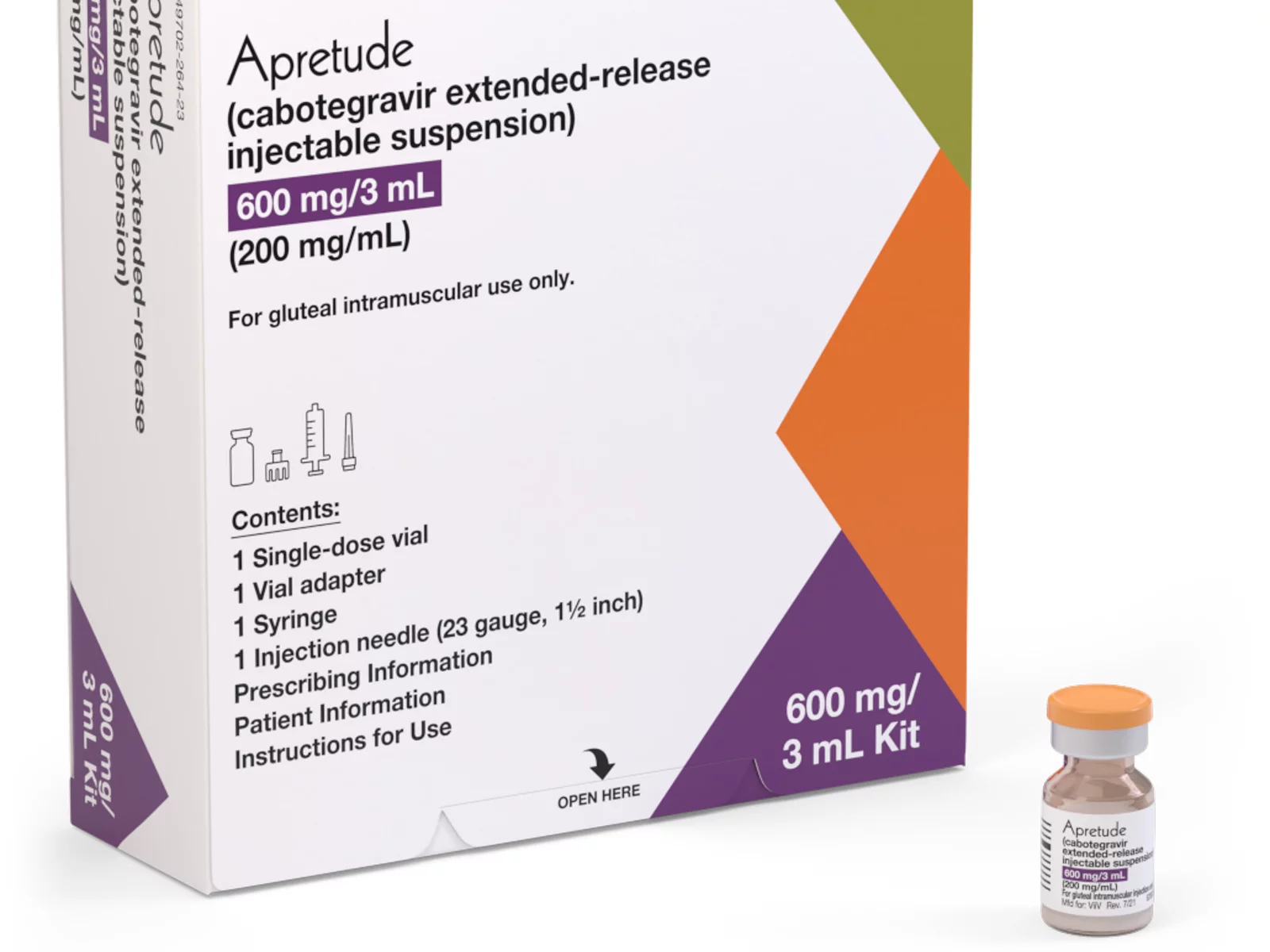
A coalition of 63 organizations dedicated to ending HIV called on the Biden-Harris administration on Wednesday to require insurers to cover long-acting pre-exposure prophylaxis (PrEP) without cost-sharing.
In a letter to Chiquita Brooks-LaSure, administrator of the Centers for Medicare and Medicaid Services, the groups emphasized the need for broad and equitable access to PrEP free of insurance barriers.
Long-acting PrEP is an injectable form of PrEP that’s effective over a long period of time. The FDA approved Apretude (cabotegravir extended-release injectable suspension) as the first and only long-acting injectable PrEP in late 2021. It’s intended for adults and adolescents weighing at least 77 lbs. who are at risk for HIV through sex.
The U.S. Preventive Services Task Force updated its recommendation for PrEP on Aug. 22, 2023, to include new medications such as the first long-acting PrEP drug. The coalition wants CMS to issue guidance requiring insurers to cover all forms of PrEP, including current and future FDA-approved drugs.
“Long-acting PrEP can be the answer to low PrEP uptake, particularly in communities not using PrEP today,” said Carl Schmid, executive director of the HIV+Hepatitis Policy Institute. “The Biden administration has an opportunity to ensure that people with private insurance can access PrEP now and into the future, free of any cost-sharing, with properly worded guidance to insurers.”
Currently, only 36 percent of those who could benefit from PrEP are using it. Significant disparities exist among racial and ethnic groups. Black people constitute 39 percent of new HIV diagnoses but only 14 percent of PrEP users, while Latinos represent 31 percent of new diagnoses but only 18 percent of PrEP users. In contrast, white people represent 24 percent of HIV diagnoses but 64 percent of PrEP users.
The groups also want CMS to prohibit insurers from employing prior authorization for PrEP, citing it as a significant barrier to access. Several states, including New York and California, already prohibit prior authorization for PrEP.
Modeling conducted for HIV+Hep, based on clinical trials of a once every 2-month injection, suggests that 87 percent more HIV cases would be averted compared to daily oral PrEP, with $4.25 billion in averted healthcare costs over 10 years.
Despite guidance issued to insurers in July 2021, PrEP users continue to report being charged cost-sharing for both the drug and ancillary services. A recent review of claims data found that 36 percent of PrEP users were charged for their drugs, and even 31 percent of those using generic PrEP faced cost-sharing.
The coalition’s letter follows a more detailed communication sent by HIV+Hepatitis Policy Institute to the Biden administration on July 2.
Signatories to the community letter include Advocates for Youth, AIDS United, Equality California, Fenway Health, Human Rights Campaign, and the National Coalition of STD Directors, among others.
-

 U.S. Supreme Court2 days ago
U.S. Supreme Court2 days agoSupreme Court to consider bans on trans athletes in school sports
-

 Out & About3 days ago
Out & About3 days agoCelebrate the Fourth of July the gay way!
-

 Virginia3 days ago
Virginia3 days agoVa. court allows conversion therapy despite law banning it
-

 Maryland5 days ago
Maryland5 days agoLGBTQ suicide prevention hotline option is going away. Here’s where else to go in Md.

